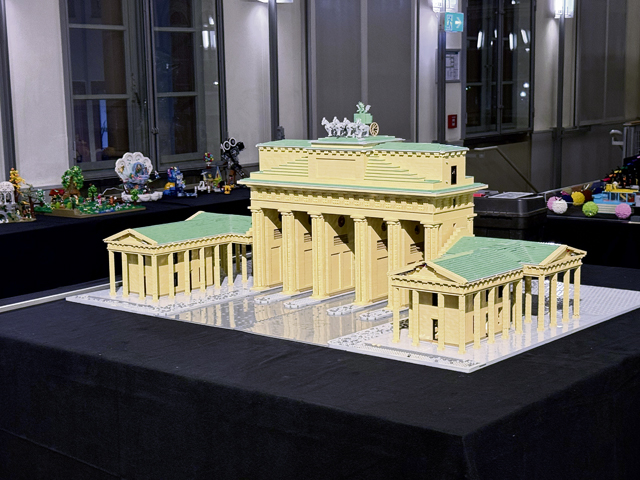
We are all familiar with the colorful, plastic building bricks that fascinate young children and adults alike. Youngsters love discovering their creativity with simple blocks, adolescents may enjoy constructing complex technical structures, while artists might even make a living out of reconstructing famous buildings of the world.
The story of the colorful bricks begins with the birth of Ole Kirk Christiansen in April 1891 in Omvraa Mark, Denmark. As one of 13 children in a poor farming family, he was fascinated by woodworks and became a carpenter.
In 1932, he established a small business in Billund, Denmark and first produced wooden household items. Inspired by his four children, he shifted his focus to wooden toys, which later became the foundation of LEGO. The name “LEGO” was established in 1934 and is derived from the Danish words “LEg GOdt,” meaning “play well.”
In 1947 Christiansen purchased a plastic injecting-molding machine, which allowed the company to mass produce plastic toys and served as a significant turning point. By 1949, LEGO was producing a simple version of the modern LEGO brick, also known as “automatic binding bricks.”
The iconic interlocking brick design was patented in 1958, shortly before Christiansen’s death in March of the same year. Little would he know that the LEGO company and his ingenious invention would lead to world-wide success and to a revenue of 65.9 billion Danish Crowns (about 9.65 billion U.S. dollars) by the year 2023.
Godtfred Kirk Christiansen, son of LEGO’s founder Ole Kirk Christiansen, took over the management of the LEGO Group in 1957. He played a crucial role in the development of the iconic LEGO brick design and the LEGO System in Play, which became the foundation of LEGO’s success.
In 1968 the first LEGO theme park was opened in Billund, Denmark. The park features large-scale LEGO models, rides and attractions along with a hotel in colorful LEGO brick style, even the nearby airport, where visitors can exit and almost stumble into the theme park, was designed in LEGO fashion.
Based on its success, further concepts were created, such as DUPLO in 1969, for younger children with larger bricks for easier handling and safer to play with. LEGO Technic was introduced in 1977 which included gears, axles and motors, allowing for more complex and functional models.
Finally, combining LEGO bricks with programmable robotics, so-called Mindstorm sets, were introduced in 1998 and enabled users to program their own robots. Themed sets such as towns, castles, space, pirates, Star Wars and Harry Potter followed, offering unique building experiences.
LEGO established its first official flower set, the LEGO flower bouquet in 2021, and it quickly became popular among flora fans. It is a part of the LEGO Botanical Collection, which includes a variety of nature-inspired builds such as sunflowers, orchids and a bonsai tree. Astrid Christiansen originally created flowers for her colleagues, but her designs quickly became popular and sparked the flame into introducing a new series with floral elements.
The concept of LEGOLAND parks rapidly gained international interest and further parks were opened in the United States, Japan and one in Germany near Ulm. The main attractions in Günzburg include MINILAND with miniature versions of famous landmarks and cities, Flying NINJAGO, a Fire Dragon roller coaster and Atlantis, an underwater world filled with sea creatures. Visitors can also experience how the bricks are made and create their own custom brick, or even stay at the Pirate Island Hotel.
Today, LEGO is more than just a toy, it’s a cultural icon. The brand has expanded into movies, video games and even as educational tools. Whether you’re building a simple house, an airplane out of DUPLOs or a complex robot, LEGO bricks offer endless possibilities for creativity and fun.
Some LEGO-tastic fun facts: Since 1958 more than 400 billion LEGO bricks have been produced. The tallest structure built with the interlocking plastic bricks measured 35.05 meters (114 ft 11 in) and was achieved by Lego Italia in Milan, Italy, on June 21, 2015. An estimated 550,000 LEGO bricks were used to complete the tower.
The largest structure in size built out of LEGO bricks was a full-sized replica of an X-Wing Fighter from Star Wars displayed in New York City. Built at a scale of 1:1, it measured 13.1 meters (43 feet) in length, with a wingspan of 13.44 meters (44 feet). Over 5.3 million LEGO bricks were used, weighing around 20 tons.
The Stadthalle in Landstuhl is hosting a large LEGO exhibit Aug. 31 to Sep. 1. The display will present over 80 LEGO master builders from Luxembourg, Switzerland and Germany, including scenes from Star Wars, a zoo landscape, knight’s kingdom, Brandenburger Tor, and a few surprises.
Dive into a miniature world, take a trip around the world, or travel into space to experience many wonders of the world in just one afternoon!


